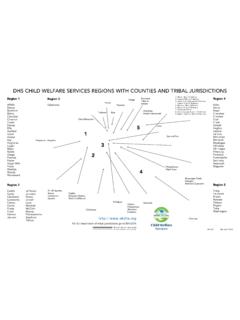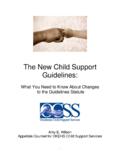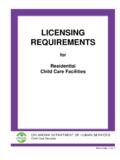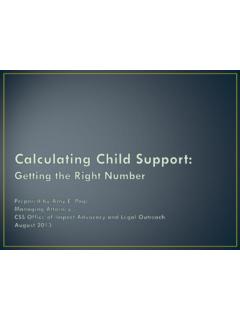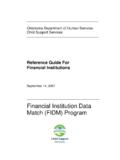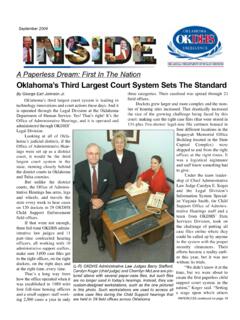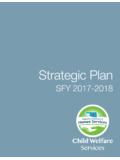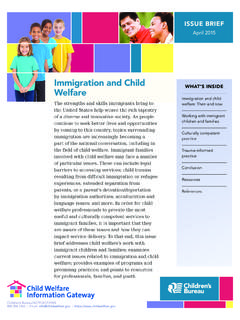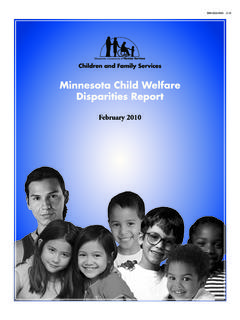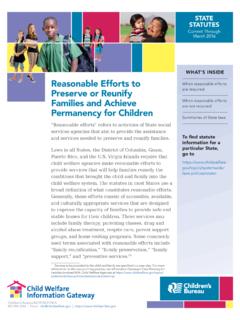Transcription of The Oklahoma Pinnacle Plan - okdhs.org
1 The Oklahoma Pinnacle plan : An Improvement plan for child welfare Services June 2012 2 TABLE OF CONTENTS TABLE OF CONTENTS .. 2 EXECUTIVE SUMMARY .. 4 ASSURANCES .. 5 STRATEGIC COMMUNICATION plan .. 5 Pinnacle POINTS .. 7 Pinnacle Point 1 Recruitment and Support of Resource Families .. 7 Pinnacle Point 2 Organizational Changes and Restructuring .. 15 Pinnacle Point 3 child welfare 22 Pinnacle Point 4 Practice Model Implementation and Permanency .. 28 Pinnacle Point 5 Quality Assurance .. 33 Pinnacle Point 6 Ensuring Safety and child welfare Staff Visitation .. 34 Pinnacle Point 7 Community Partnerships and External Stakeholders ..37 GLOSSARY .. 41 The Oklahoma Pinnacle plan : An Improvement plan for child welfare Services June 2012 3 If we don't stand up for children, then we don't stand for much. Marian Wright Edelman The Oklahoma Pinnacle plan : An Improvement plan for child welfare Services June 2012 4 EXECUTIVE SUMMARY There is no greater purpose than ensuring the safe futures of abused and neglected children.
2 The Marian Wright Edelman quote was selected for the powerful way it communicates the critical role of advocating for children. It reflects the mission of Oklahoma s child welfare professionals to stand up for children in harm s way. Each day, under the most difficult of circumstances, child welfare professionals work to keep families together when safely possible. When this is not possible, they search for relatives and resource parents to support children and families so reunification can happen. When reunification is not possible, they work to place children with families where they can lead safe, healthy lives and maintain connections to their kin, culture, and community. The work in child welfare has always been difficult and complex. Oklahoma s child welfare system has been challenged to do it better.
3 On January 4, 2012, the Oklahoma Department of Human Services ( okdhs ), jointly with the Governor s Office and the Oklahoma Commission for Human Services, reached an agreement with the plaintiffs in class action litigation DG vs. Yarbrough, Case No. 08-CV-074. As part of this agreement, okdhs was to develop an improvement plan for child welfare services ( Pinnacle plan ) with assistance of key internal and external stakeholders and approval of the Co-Neutrals. The Pinnacle plan details a five-year plan , beginning with State Fiscal Year (SFY) 2013, to address 15 performance areas identified in the agreement. The Pinnacle plan establishes the direction, expectations, and values from which the workforce will operate, resulting in more empowered families and a more empowered agency that knows where it is going and why. We expect this will lead to better outcomes for children and families and a stronger and better-aligned workforce, a greater degree of internal and external collaboration, and greater service flexibility and innovation.
4 okdhs must instill a sense of hope and forward progress among our families, children, staff and community. The Pinnacle plan outlines the commitments and critical initiatives that will be implemented to better serve children and their families. Pinnacle plan initiatives are based on a set of new core commitments that represent the foundation of reform. These include, but are not limited to: expansion of resource homes, new caseload standards, reduction in use of shelter care, termination of shelter care for young children, consistent and timely investigations and reporting of child maltreatment in care, and effective and streamlined staff hiring and training. okdhs is committed to: equity, where all children, youth, and families have access to and receive unbiased treatment and services; keeping children safe with their families through prevention services, kinship placements, and timely reunification whenever possible; The Oklahoma Pinnacle plan : An Improvement plan for child welfare Services June 2012 5 ensuring every child is safe while in out-of-home care and custody by recruiting, retaining, and supporting resource families who best match the needs of the children and can provide for their safety, permanency, and well-being; moving to a continuum of care that best meets the needs of children in out-of-home care and provides for the least restrictive family-like placements, except in extraordinary circumstances.
5 Recruiting, retaining, and supporting the best child welfare staff through a commitment to ongoing staff development and ensuring manageable caseloads and workloads; and engaging local communities and agency partners in improving child welfare outcomes. We cannot do it alone. ASSURANCES How The Pinnacle plan Will Drive Improvement in Oklahoma s child welfare Services okdhs leadership developed the Pinnacle plan to provide a clear and action-oriented plan for improving the lives of children, youth, and families served by the child welfare system. okdhs will successfully implement the plan and will condition the agency to work on a range of improvements every day, at all levels, and in all functions. Priorities for change and improvement will be linked to a strong family-centered practice model, reinforcing that model at every turn. This will be accomplished through updated and revised training, structured and supportive supervision, an effective organizational and management structure, quality assurance activities, and public reporting of outcomes.
6 Children and their families will have access to a comprehensive array of services, including intensive home-based services, designed to enable children to achieve positive permanency outcomes. okdhs needs the support of external stakeholders, the community, the Oklahoma Legislature, the Governor s office, the media, and local and federal partners to make change happen. In summary, the Pinnacle plan is crafted and timed to address performance deficits to achieve improvement. okdhs leadership, including the Governor, the Commission for Human Services (and any successor entity or entities), the Director, and agency staff, are committed to successfully completing this plan and improving the quality of the program and outcomes for children and families. STRATEGIC COMMUNICATION plan The confidence and trust of both internal and external constituencies was critical to the development of the Pinnacle plan and is critical to its implementation.
7 This process has been and will continue to be as transparent as possible to create trust and ensure effective two-way communication. While different groups of stakeholders have varied interest levels for information, communications surrounding the Pinnacle plan will continue to be detailed, and The Oklahoma Pinnacle plan : An Improvement plan for child welfare Services June 2012 6 the same information will be made publicly available. A specific space on the okdhs website, , is set aside to provide updates on the Pinnacle plan development and implementation. The purpose of a strategic communications plan is to connect the public with the work of the organization. For this reason, a strategic communications plan was developed for the Pinnacle plan to identify methods of eliciting feedback and informing the public and key stakeholders of progress.
8 The Oklahoma Pinnacle plan : An Improvement plan for child welfare Services June 2012 7 We must expand quality placement options and supports to ensure safety of children in out-of-home care, reduce utilization of shelter care, improve placement stability, and to achieve positive permanency outcomes. Oklahoma needs new and innovative ways to recruit, retain, and support resource families. Stable families provide children with experiences they need for healthy development in all aspects of life including social, physical, and emotional well-being. Every child deserves to be with a family that meets his or her safety, permanency, and well-being needs. Each child in out-of-home placement should be matched with a family that keeps him or her with siblings and close to school and community. Each child deserves a family that understands the impact of the trauma experienced by most children entering out-of-home care, helps the child heal from this trauma, and keeps the child even in tough times so the child does not have to change placements.
9 okdhs shall place children according to the following standards and shall be consistent with placement preferences outlined in Section 1-4-204 of Title 10A of the Oklahoma Statutes and the federal Indian child welfare Act (ICWA). All children shall be placed in accordance with their individual needs, taking into account a child s need to be placed as close to home and community as possible, the need to place siblings together, and the need to place children in the least restrictive, most family-like setting. Children for whom adoption is the permanency goal should, whenever possible, be placed with a family where adoption is a possibility. Children will be placed with families so they do not experience temporary shelters. Meeting the Need okdhs must have an adequate number of resource parents. okdhs has not been able to meet this need in the past, but that is going to change.
10 Improvement in this area is critical and addresses many of the 15 performance areas. If every child has the right resource family, a reduction in abuse and neglect in care, placement instability, shelter care utilization, failed adoptions, and older youth aging out of the system without a permanent family will be achieved. To improve its placement array, okdhs commits to recruit and approve 500 additional non-relative resource homes. okdhs approved 1,444 families for non-relative resource homes during SFY 2011; okdhs will approve 1,944 new families for non-relative resource homes during SFY 2013. Additionally, Oklahoma needs an increase in Therapeutic Foster Care (TFC) homes to keep youth closer to their families and out of higher levels of congregate care. During SFY2011, okdhs and TFC agencies approved 89 new TFC families.
